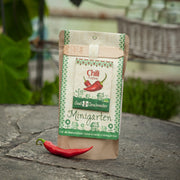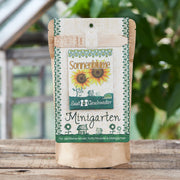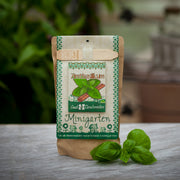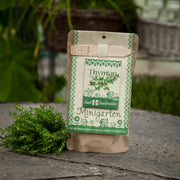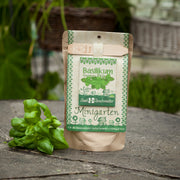Mehr grün in deinem Leben.
Unser Minigarten schafft eine grüne Oase in jedem Zuhause. Ob auf der Fensterbank oder dem Balkon, er bringt dich zurück zur Natur und macht Lust auf frische Leckereien.
Alles was du brauchst, ist schon drin:
Erde, hochwertiges Saatgut und ein Pflanzstäbchen. Die Verpackung besteht aus einem wasserfesten Beutel, der direkt als Pflanz- oder Anzuchttopf verwendet werden kann. Los geht's!

Wir haben gerade ein super Angebot für dich: Beim Kauf von 4 Minigärten schenken wir dir einen fünften gratis dazu! Lege dafür einfach fünf Minigärten deiner Wahl in deinen Warenkorb und gib im Checkout den Code "Minigarten" ein – schon geht der fünfte Minigarten auf uns!
Grow kits and mini gardens - the perfect gift
From now on, it's time to garden on your windowsill! Whether it's herbs, vegetables, or fruit, with our mini gardens, these delicacies will be just an arm's length away. A planting stick, soil, and seeds – the mini garden contains all the ingredients you need to get started right away. Our beautiful growing kits make perfect gifts and souvenirs for all hobby gardeners and those who want to become gardeners.
Mini Garden - The Gardener's Starter Kit
With this mini garden, you can ring in and enjoy the planting season on your windowsill. This small bag contains the best garden soil and the finest seeds. Simply cut open the bag, sprinkle the seeds into the soil, keep it moist, and place your mini garden in a warm, sunny spot. With a little love and patience, you'll be able to proudly observe your young plants' first steps in just a short time.
To ensure successful cultivation, you'll find instructions and specific planting tips for each variety inside the seed packet. If your seedlings are getting too crowded in their home and you have enough space, simply tear open the packet and plant them outdoors.
What is a growing kit?
Cultivation is nothing other than the nurturing of young plants. They're similar to children in many ways; both require a lot of care, love, and time, as well as favorable conditions to grow. Are you longing for homegrown vegetables or fresh herbs, but are new to the cultivation business? You've come to the right place!
We also call our growing kits mini gardens, but they shouldn't be confused with miniature green spaces. They're for anyone who wants to start their little plants early without leaving them to the whims of nature too soon. Because sometimes it just doesn't work without growing them. Some plant varieties, such as cucumbers and tomatoes, but also pumpkins, aren't native to our area and therefore need different conditions to survive. They need the warmth and protection of your own home or greenhouse so that they'll be strong enough to face the demands of nature later on. Growing plants at home is very common and prevents seedlings from dying too early because the weather was once again unpredictable. This also applies to native vegetables and fruit! While they're much more likely to germinate happily in the garden without help, prior cultivation speeds up the process and ultimately leads to a higher yield.
The right timing
Now you know what growing plants is all about. But at least as important as the why is the when , because the right timing for growing and sowing can make a huge difference and often determines the success of your harvest. While you're here, we've put together a rough overview for you:
| time | Plant species |
|---|---|
| February | Pepper and tomato plants |
| March | Brassica vegetables (broccoli, cauliflower, kohlrabi, red and white cabbage, lettuce) |
| April | Brussels sprouts and popular herbs such as basil and dill |
| May | Endive and kale |
| June | Chinese cabbage |
To find the right variety for you, you can also use the "sow in" filter at the top of this page
Cultivation – How does it work?
Once you know when you need to grow your seedlings, it's time to place the seeds in moist potting soil and press them down lightly. Potting soil is ideal for emerging plants because it's particularly low in salt and germs. This way, your plants will grow particularly strong and less susceptible to disease. After gently pressing the seeds down, cover the seeds with a little soil, ideally as much as the seed is large and definitely no more than 1 to 2 cm. But be careful! The exception to this are light-germinating plants; these should be barely covered, if at all , so they can soak up plenty of sunlight.
Light-germinating varieties in our growing kits include: basil, dill, mint, oregano, coneflower, thyme, lavender, chamomile, carrots, wild garlic, lettuce, rosemary, and lemon balm. But don't worry: The planting instructions included with each variety also describe exactly how to do it.
Let love germinate! And your plants too
If you're still hesitant about planting the seeds in the soil right away, you can, of course, let them soak first to be on the safe side. There are special soaking tablets available to help you with this.
Our growing kits naturally include high-quality potting soil, which creates perfect growing conditions for your green friends. While there are mini greenhouses available for home use that provide plants with an optimal climate, our sturdy growing kit bag also creates good conditions. Your plant also needs to be able to breathe; you can do this by simply poking a few holes in the cover. If you haven't already pre-germinated your seeds in seed pellets, you must keep the seeds moist. The best way to do this is with rainwater or water that's low in lime. If you only have hard water at home, you can also soften it with water filters. Dry seeds won't germinate, so double-check that the growing soil is as moist as it should be.
Afterward, it's important to store the container in a warm, sunny location. Warm, in this case, means a comfortable room temperature of 22-25 degrees Celsius, although this can vary from variety to variety. Now, patience is key. Depending on the plant species, it can take several weeks for the first shoots to appear.
After germination
Since young plants, like small children, are very fragile, you should leave them alone during this time. Once you see the first green stems sprouting, you must be absolutely careful to avoid waterlogging . This could cause long-term damage to your young plant. Did you once again forget whether you watered it this morning? It can happen! Simply feel the soil and check how moist it is. Once the first shoots appear, it's also important to bring the outside temperature up to about 18 degrees.
Prick out plants
Transplanting simply means planting or separating your young plants at greater distances from each other. This should be done when they are in each other's way and the small stems already protrude about 10 centimeters from the soil. At this point, they are strong enough to withstand transplanting. To do this, carefully dig up the plants and separate the roots. This is best done with a small spoon or a dibber. This is especially useful if you plan to transplant plants frequently.
When transplanting, be careful to damage as few of the fine roots as possible, as these are the plant's way of absorbing water. Once you've successfully transplanted them into their own pots, they can now form a good root ball. To stimulate root growth, there's potting soil, which, unlike potting soil, contains a bit of fertilizer.
The big repotting
If your transplanted plants become too large for their pots, you can now either release them into your garden or get a larger planter.
Of course, you'll need to repot not only your cultivated plants from time to time, but also your other houseplants. To do this, take a look at their roots. If they're growing upwards or even emerging from the drainage holes at the bottom, your plant is telling you that it desperately needs more space to develop. You should always pay attention to this when purchasing plants to determine whether they need to be repotted.


















